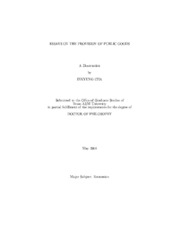| dc.description.abstract | In Chapter 2, we present a model that allows us to study the effect of
increased competition among charities for donations, and show that it will
result in a lower provision of public goods. When charities get donations,
they must pay two fundraising costs: a travel cost and an extra cost, a
"premium" in our terminology. This
premium arises from the extra time, effort, or incentives a charity must
provide to garner a contribution from a donor who is solicited by other
charities. Increased competition raises this premium, which leads to
deadweight loss, so that revenue net of fundraising costs falls after a new firm
enters into the market.
A problem with public goods markets is asymmetric information between
charities and donors, such that donors do not know which charities will cheat. In Chapter 3, we show that honest charities can get more
donations than dishonest charities by investing in a capital stock. We study
a two-period model under two assumptions, one where first-period investment
does not affect the provision of public goods in the second period, and one
where first-period investment does affect the provision of public goods in
the second period. In the first case, we prove the existence of a separating
equilibrium where honest charities make an investment and dishonest charities invest nothing. Thus, donors will donate
more to charities that make investments, even if the investment is not used
to produce public goods. In the second case, honest charities may invest the
efficient amount, overinvest, or underinvest, depending on the donors'
beliefs.
In Chapter 4, we borrow parts of the models in the
previous two chapters in order to see what effect the signaling cost has on
the number of firms and average revenue. In our model, donor utility
increases when they give to a charity that matches their ideology. We are
interested in the long-run equilibrium, so unlike in Chapter 2, we assume
there is free entry in the market. The two important results are that the
number of firms decreases and average revenue increases if the required signaling cost
increases. | en |


